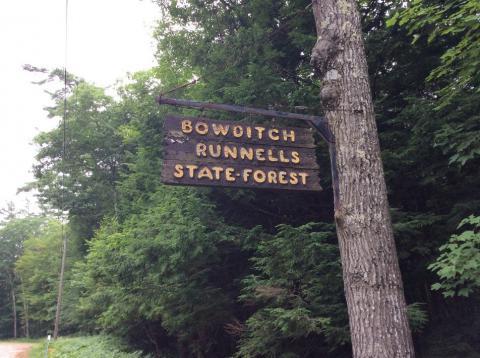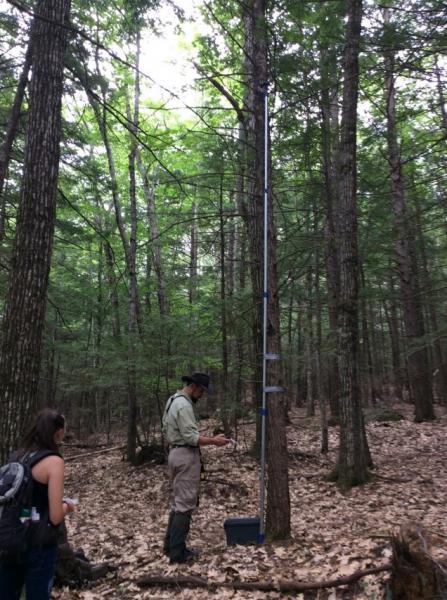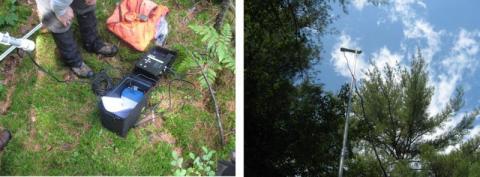Finding A Balance: Harvesting Timber and Protecting Bats

Last summer, I met with Sam Taylor, a forester with the N.H. Division of Forests and Lands, to learn about how the Division is monitoring for bats on some of its properties. He was in Carroll County, setting up acoustical monitoring equipment in the Bowditch-Runnells Forest in Tamworth. The forest is slated for a timber sale, and a summer (bare ground) harvest is preferred on this property to encourage white pine, red oak and hemlock regeneration. Summer harvesting, however, has the potential to impact several state-endangered bat species. Sam was there to find out what bats may be there, and to ensure they are not impacted by harvesting.
New Hampshire is home to eight species of bats, and the N.H. Wildlife Action Plan identifies all of our bat species as species of conservation concern. Four of these species are designated as state endangered, including the northern long-eared bat (which is federally threatened as well), tri-colored bat, eastern small-footed bat, and little brown bat.
According to the U.S. Fish and Wildlife Service, “Bats are critical to our nation’s ecology and economy, eating tons of insects nightly and providing a natural benefit to farmers and foresters. Some research estimates that bats provide at least $3 billion annually in economic value.”
The deadly fungus White-Nose Syndrome, first detected in New York in 2006, has killed millions of bats in the eastern United States, causing dramatic drops in populations of once common bat species. The fungus weakens bats while they are hibernating, causing dehydration and increased activity that depletes the fat reserves the bats depend on to survive until spring (when their food sources – insects – are once again abundant). White-Nose Syndrome affects five species of New Hampshire bats that hibernate, including tri-colored bats, eastern small-footed bats, little brown bats, big brown bats, and northern long-eared bats.
Forest managers are trying to reduce negative impacts to these already stressed species. All of New Hampshire’s bats eat insects, and during the spring, summer, and fall they inhabit our fields, forests, wetlands, and water bodies foraging for these insects, seeking water, and roosting. In general, forest management and timber harvesting are not detrimental to bats; instead, harvesting contributes to the creation of diverse habitats on the landscape. However, the timing of forest management activities has the potential to negatively impact bats.

The bat monitoring set up used by the N.H. Division of Forests & Lands.
To protect bats, winter harvesting is preferable because bats are either hibernating in caves and mines, or they have migrated away from our forests. In the summer, many of New Hampshire’s bat species stop to rest by roosting in trees or other sheltered places like attics and barns, while other species roost in rocky crevices.
The biggest concern in the summer is harvesting a roost tree with bats in it. The females of species such as big brown bats, little brown bats, and northern long-eared bats form maternity colonies and roost together, often returning to the same general area year after year. Johnson and King (2018) note that most bats prefer to roost in large-diameter trees and snags, which generally persist longer than smaller snags and can support more roosting bats. These trees often have characteristics such as cavities, crevices and exfoliating bark that are attractive to bats. The N.H. Division of Forests and Lands makes an effort to retain snag trees where possible, for bats and the other wildlife species that use them.
To reduce the potential for removing a roost tree with bat pups in it, it is important to avoid harvesting when bat pups are most at risk – between June 1 and July 31. This is when mother bats are roosting with their babies who are not yet able to fly. The consequences of mistakenly harvesting a roost tree could have significant impacts for these species at risk. If bats are found during acoustical sampling, the N.H. Division of Forests and Lands tries to avoid harvesting between May 1 and August 15.
In many cases, it is easy to avoid impacting bats by harvesting in the winter. In some cases, however, foresters want to conduct a harvest in the summer on bare ground to scarify the soil, which helps to regenerate valuable timber species such as white pine. The challenge in conducting a summer harvest is that we don’t know where the roost trees are, and the bats seem to move to different roost trees periodically throughout the summer.
The N.H. Division of Forests and Lands annually conducts an average of 15-20 timber harvests. Many of these harvests are conducted in the winter on frozen ground while bats are hibernating and not using roost trees. For those few timber harvests that are potentially scheduled for the summer, Sam visits these sites to determine whether bats are present prior to any harvest activity.
As you might imagine, finding and identifying bats is not an easy job. Sam sets up poles with microphones attached. Bat monitors are powered by a rechargeable battery, and the monitors collect echolocation calls from bats. Specialized software is used to determine which bat species (or in some cases – groups of species) are making those calls. Depending on the acreage of the timber sale, several monitors are set up across the sale area and record data for several nights.
Planning is important as there are many factors affecting the quality of the data. Rain, wind, and cool temperatures are all factors that impact the monitoring as these weather conditions tend to reduce bat activity. The monitors collect data between 5 p.m. and 6 a.m. At the Bowditch-Runnells State Forest, two monitors were set up to collect data for a week.

Box containing the bat monitoring unit (left), and microphone in a protective tube mounted on a pole (right).
Once collected, the data is sent to the U.S. Forest Service where they analyze the data and determine what types of bats have been active in the area. If species of concern are detected (which include tri-colored, eastern small-footed, little brown, and northern long-eared bats) then the contract for that timber sale will specify that harvesting needs to be completed outside the May 1 - August 15 time frame.
The reduced time frame for harvesting can be challenging. Prior to White-Nose Syndrome, many bare- ground harvests could easily be completed between June and December. These timber sales may now take two years to complete with the reduced window.
As good stewards, the N.H. Division of Forests and Lands is working to balance timber and wildlife considerations, and on-going monitoring efforts will help us learn more about these elusive bat species that share our landscape. Spending time with Sam and learning more about New Hampshire’s bats really opened my eyes – and ears – to the importance of taking them into consideration when planning a timber harvest.
By Wendy Scribner, Natural Resources Field Specialist, UNH Cooperative Extension
2020 Fall Taking Action for Wildlife Newsletter


